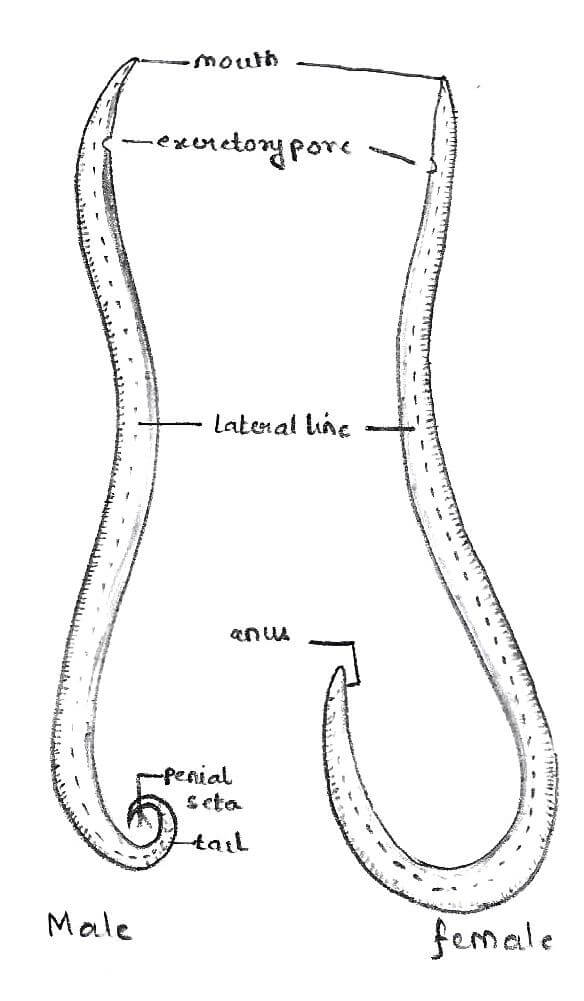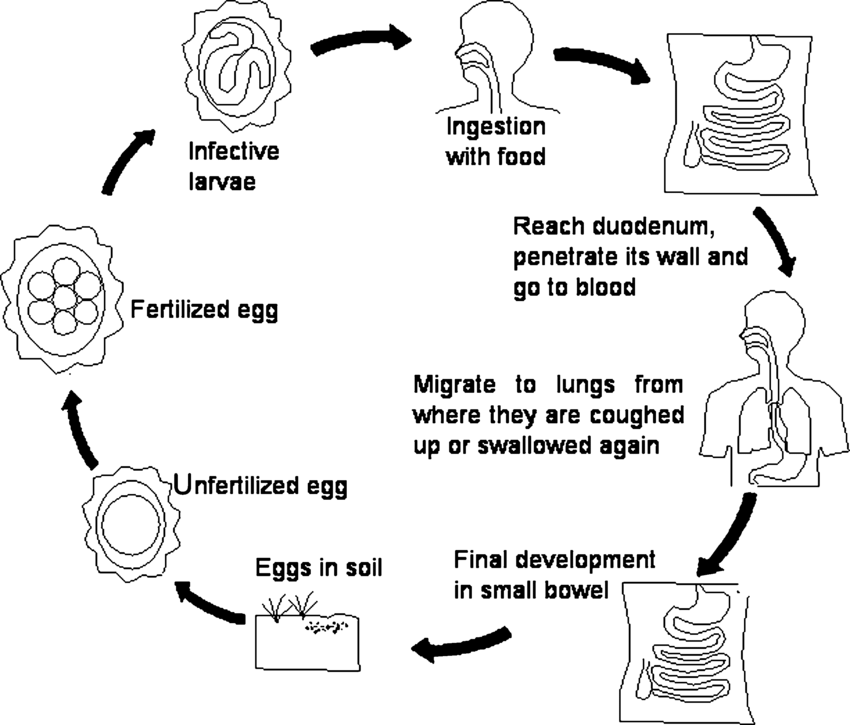What is Ascaris lumbricoides?

Ascaris lumbricoides is a type of roundworm that lives in the human intestine. It is one of the most common worms that infect people, especially in places with poor sanitation and hygiene. The disease caused by this worm is called ascariasis. It mostly affects children and can lead to a range of health problems from mild stomach issues to serious complications.
Table of Contents
Morphology of Ascaris lumbricoides
Ascaris is a long, round worm that looks like a large earthworm. Its body is smooth, firm, and tapered at both ends. It is usually white or pinkish in color.
Size: Male worms are smaller (15–30 cm long), while female worms are larger (20–40 cm long).
Body features: The worm’s body is covered with a thick outer layer that protects it. Its mouth has three lips. Males have a curved tail, while females have a straight one.
Eggs: The eggs are very tiny and can only be seen under a microscope. Fertilized eggs are round or oval with a thick shell, while unfertilized eggs are longer and thinner.
Life Cycle of Ascaris lumbricoides with diagram

The worm’s life cycle is simple and needs only one host – humans.
Imagine tiny, invisible eggs hiding in dirt, dirty water, or on unwashed vegetables. When someone accidentally swallows these eggs (maybe by eating food with dirty hands or drinking contaminated water), the trouble begins. Here’s what happens next:
1. Eggs Get Swallowed & Hatch in the Gut
- The eggs travel to the small intestine (the part of your gut that absorbs food).
- Inside, baby worms (larvae) break out of the eggs.
2. Baby Worms Go on a Body Tour
- These tiny worms burrow through the intestine wall and sneak into the bloodstream.
- The blood carries them to the lungs (yes, your breathing organs!).
3. Lungs: A Temporary Stop
- In the lungs, the worms grow a bit and can cause coughing or even a mild fever.
- When you cough, you might swallow them again, sending them back to the gut.
4. Back to the Gut – Now Grown Up
- Once back in the intestines, the worms grow into adults (some as long as a pencil!).
- They live there, stealing your nutrients, which can make you feel weak or sick.
5. Laying Eggs & Spreading the Problem
- Female worms lay thousands of eggs every day.
- These eggs leave your body through poop. If poop isn’t disposed of properly, the eggs go back into the soil, waiting to infect someone else.
Pathogenesis (How It Makes You Sick)
The illness caused by Ascaris happens in two main ways—when the larvae move through the body and when the adult worms live in the intestine.
Larvae moving in the body
When the larvae pass through the lungs, they can cause coughing, wheezing, and breathing problems. This stage is sometimes called Loeffler’s syndrome and is marked by inflammation in the lungs and an increase in certain white blood cells (eosinophils).
Adult worms in the intestines:
- They can cause stomach pain, bloating, and discomfort.
- In some cases, they can block the intestines, especially in children.
- Sometimes, worms leave the intestines and travel to the bile duct, liver, or appendix, causing more serious problems like liver abscess or appendicitis.
Laboratory Diagnosis (How Doctors Find It)
To confirm the infection, doctors use the following tests:
- Stool test: This is the main way to find Ascaris. The lab looks at a stool sample under a microscope to check for the eggs.
- Concentration methods: These are used when the number of eggs in the stool is very low and hard to see.
- Imaging tests: X-rays, ultrasounds, or endoscopy may be used if there is a blockage or if worms are seen moving in the body.
- Blood test: During the early phase (larvae migration), the number of eosinophils (a type of white blood cell) in the blood is often high.
Treatment (How to Get Rid of It)
Medicines (Anthelmintics):
- Albendazole (400 mg) – taken once.
- Mebendazole (100 mg twice a day for 3 days or a 500 mg single dose).
- Other options include Pyrantel pamoate or Ivermectin.
For severe cases:
- If the worms cause a blockage in the intestines or travel to other organs, the person may need to be admitted to a hospital.
- Sometimes, surgery is required to remove the worms.
Prevention (How to Stay Safe):
- Always wash hands with soap and water, especially before eating and after using the toilet.
- Wash fruits and vegetables properly before eating.
- Drink clean and safe water.
- Use toilets; avoid open defecation.
- Educate people about personal hygiene and cleanliness.
- Regular deworming programs in schools and communities can help reduce infections.
Conclusion
Ascaris lumbricoides is a common and dangerous parasite, especially in areas with poor hygiene. Though it can be treated easily with medicines, preventing the infection is much better. By improving sanitation, practicing good hygiene, and doing regular deworming, we can reduce the spread of this parasite and keep people, especially children, healthy and safe.
Frequently Asked Questions (FAQ)
What is ascaris lumbricodes ova?
Ascaris lumbricoides ova are the eggs of a parasitic roundworm that lives in the human intestines. These eggs are passed in the stool of infected people and can survive in soil for a long time. If someone swallows the eggs through contaminated food or dirty hands, they can become infected. The worms can grow inside the body and cause stomach pain, weakness, or other health problems.
Who discovered ascaris lumbricoides?
Ascaris lumbricoides was first described by the ancient Greek doctor Hippocrates, but it was later studied in more detail by scientists like Carl Linnaeus in the 1700s. Linnaeus gave it its scientific name and helped classify it as a roundworm that lives in the human intestines.
Which disease is caused by ascaris lumbricoides?
Ascaris lumbricoides causes a disease called ascariasis. It happens when someone accidentally eats the worm’s eggs, usually from dirty hands or food. The worms grow inside the belly and can cause stomach pain, tiredness, or even a blockage if there are too many.
Related Articles




